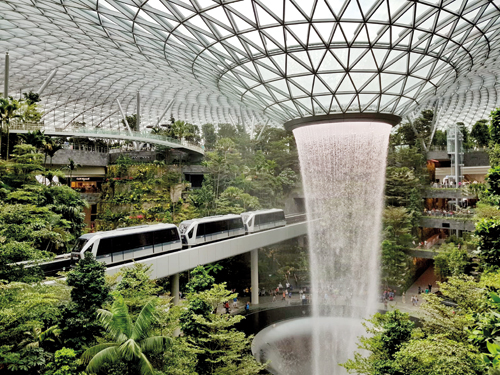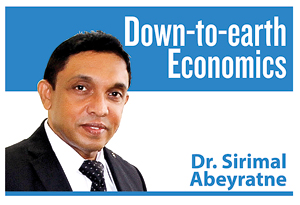The Singapore formula
View(s):
A jewel added recently to the Singapore Airport. “The Jewel” is located in the heart of the airport with exciting green lush and landscaping, shopping mall and a hotel with over 100 rooms. Picture by Chathurani Abeyratne
Many years ago, my first visit to Singapore was a long stopover at the Singapore Airport, which was a memorable one. I had to wait about half a day for my connecting flight to Melbourne.
Singapore Airport was big, and it never stopped becoming bigger and better in order to accommodate the ever-growing air-travel passenger movements; today it handles over 65 million passengers a year. Singapore has built its airport not only to accommodate millions of passengers, but also to provide them with pleasant and enjoyable environment and services within the airport.
A few decades ago, perhaps, Singaporeans came to Colombo to get their connecting flights. The late Prime Minister of Singapore, Lee Kuan Yew had mentioned in his book – The Singapore Story, how he had a stopover in Colombo “on his way to London.”
How to become No.1?
I walked here and there, spent time in duty free shops, and glanced at books at the bookshops. Airport bookshops are particularly interesting, because they serve only particular interests. One of the most common books that you find in airport bookshops is about “how to become No.1?”
Here is Singapore which became No. 1 in Asia. It started off with US$500 per capita income at the time of its “unwanted” independence from Malaysia, and became the “richest nation in Asia” with more than $50,000 per capita income today.
It was not only the richest in Asia, it was also the “fastest in Asia” to become rich! Therefore, the matured-adult and elderly Singaporeans who live today in Asia’s richest country, were actually born in a poor country.
When Singapore was separated from Malaysia in 1965 and was left helpless to be on its own, it had no hope of survival. With less than 2 million people living in a country which was smaller than the Colombo district, Singapore was considered to be “too small to survive.” On top of all that, there were ethnic conflicts among the people, divided on ethnicity and language.
Disciplinary boundaries
For transit passengers who are staying long hours at the Singapore Airport, there were “city tours” free of charge. I thought: “Why not keep sitting in a tourist coach looking around the city rather than wandering inside the airport?” Since I still had few more hours to spend, I joined it too.
The tourist guide – a smartly dressed, pleasant, and knowledgeable person -, welcomed the group of about 20 passengers to the coach, introduced himself and explained about the tour. Then he said: “You can ask any question on the way, except those which might be politically-sensitive!”
It must have surprised many in the group, but nobody dared to ask him why he said that. Perhaps, it might turn out to be politically-sensitive too!
But his request, or rather the advice, implied to me the “discipline” much more than anything else. The discipline is utmost important to lead Singapore to prosperity and to maintain its social and political stability.
Secret formula
Why did Singapore become rich? Why did it become rich so fast? And why has it never stopped becoming richer by surpassing all the nations in Asia?
Being a student of economics, searching answers to a question as such never made me bored. Therefore, learning about “why some countries are rich, while others are poor” has always fascinated me. And the answers often run beyond economics.
Today, I also choose to answer the above question going beyond economics. The answer is based on the Singaporean Prof. Kishore Mahbubani’s “secret MPH formula” which he used to describe the success of Singapore. Prof. Mahbubani was a diplomat as well as an academic, who retired recently after serving 13 years as the Dean of the Lee Kuan Yew School of Public Policy, National University of Singapore.
I decided to reveal his secret MPH formula to answer not only the question of “Why Singapore became rich?” but also the question that “Why some others remain poor?”
Even if others adopt the same economic policies as Singapore did, the secret MPH formula would tell us that they are unlikely to succeed. Then, many would start condemning the “policies” with a wrong diagnosis, thinking that policies were responsible for keeping the nation poor!
Right people for the job
The MPH formula presents three elements that Singapore adopted in governing the nation: the abbreviation MPH stands for Meritocracy, Pragmatism, and Honesty.
Meritocracy is the “merit-based selection of right people” to run the country and the institutions. Many developing countries around Singapore had failed because the leaders used to pick up their family members, relatives, supporters, and buddies without any consideration to their competence to do the job.
But Singapore did the opposite: The political leadership of Singapore selected the “best” people with proven competence to fit the job: the Cabinet Ministers, the Parliamentarians, the bureaucracy, and the heads of public enterprises.
Someone might ask the question that then, how did Lee Kuan Yew select his elder son, Lee Hsien Loong, to be his successor as the Prime Minister. In spite of being the son, he was competent to be the head of country. He had a brilliant educational record at both Cambridge and Harvard universities as well as proven track record of competency to provide the leadership.
Singapore also adopted two important strategies to generate a “globally-competitive” labour force to contribute to its development. One is its education system which enabled Singapore to build one of the best educated population in the world with a global exposure. Second is the opening of the country to attract and retain talented foreign labour in Singapore.
Cat, made of wax or clay?
The second element in the MPH formula is the pragmatism – an application of solutions without being bonded with any doctrinal ideology. Ideologies seem dominating the policy-making in many developing countries, while some of these ideologies are leaders’ own imaginations. The policies based on ideologies always lead to “experiments”, and the experiments can either succeed or fail.
 What was important for Singapore was that “if the cat catches mice, it doesn’t matter whether the cat was made of wax or clay”. Without trying to re-invent the wheel, Singapore “cut and pasted” the best practices from around the world. It didn’t matter, if such practices were from the capitalist world or the communist world.
What was important for Singapore was that “if the cat catches mice, it doesn’t matter whether the cat was made of wax or clay”. Without trying to re-invent the wheel, Singapore “cut and pasted” the best practices from around the world. It didn’t matter, if such practices were from the capitalist world or the communist world.
Singapore also learnt from others’ mistakes in order to make sure that they were not imported to be implemented in Singapore. Lee Kuan Yew quoted ample such “mistakes” from many other countries in the neighbourhood, including
Sri Lanka.
Getting the “top” honest
The third element in the MPH formula is the honesty of leaders, aiming at building a “corrupt-free” society. “Corruption at the top level” is the biggest issue of many developing countries, which pulled them down. When the “top level” is corrupt, it is impossible to deal with “lower levels” of corruption so that the countries get entangled in it without a way out.
In this case too, Singapore did the opposite by punishing the “top level” first, before turning towards the “lower levels”. Once a Deputy Minister of Singapore government went on a holiday with his friend, as Prof. Mahbubani explained. On returning after the holidays, the Deputy Minister was arrested, made liable for corruption, and was sent to prison.
It became a question even to the defendant as to why was he arrested on baseless corruption charges. It was revealed that he went on a holiday with his friend who was a businessman and, who paid his hotel bills; that was corruption!
Singapore’s secret formula teaches us not only why Singapore became rich, but also why many other countries cannot become rich.
(The writer is a Professor of Economics at the University of Colombo and can be reached at sirimal@econ.cmb.ac.lk).


